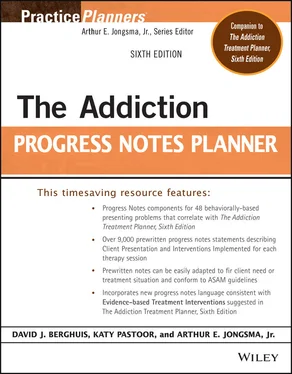The Addiction Progress Notes Planner
Здесь есть возможность читать онлайн «The Addiction Progress Notes Planner» — ознакомительный отрывок электронной книги совершенно бесплатно, а после прочтения отрывка купить полную версию. В некоторых случаях можно слушать аудио, скачать через торрент в формате fb2 и присутствует краткое содержание. Жанр: unrecognised, на английском языке. Описание произведения, (предисловие) а так же отзывы посетителей доступны на портале библиотеки ЛибКат.
- Название:The Addiction Progress Notes Planner
- Автор:
- Жанр:
- Год:неизвестен
- ISBN:нет данных
- Рейтинг книги:5 / 5. Голосов: 1
-
Избранное:Добавить в избранное
- Отзывы:
-
Ваша оценка:
- 100
- 1
- 2
- 3
- 4
- 5
The Addiction Progress Notes Planner: краткое содержание, описание и аннотация
Предлагаем к чтению аннотацию, описание, краткое содержание или предисловие (зависит от того, что написал сам автор книги «The Addiction Progress Notes Planner»). Если вы не нашли необходимую информацию о книге — напишите в комментариях, мы постараемся отыскать её.
The Addiction Progress Notes Planner, Sixth Edition
Addictions Treatment Planner, Sixth Edition
Addiction Treatment Planner, Sixth Edition
The Addiction Progress Notes Planner
The Addiction Progress Notes Planner — читать онлайн ознакомительный отрывок
Ниже представлен текст книги, разбитый по страницам. Система сохранения места последней прочитанной страницы, позволяет с удобством читать онлайн бесплатно книгу «The Addiction Progress Notes Planner», без необходимости каждый раз заново искать на чём Вы остановились. Поставьте закладку, и сможете в любой момент перейти на страницу, на которой закончили чтение.
Интервал:
Закладка:
NOTES
1 *The numbers in parentheses correlate to the number of the Behavioral Definition statement in the companion chapter with the same title in The Addiction Treatment Planner, Sixth Edition, by Perkinson, Jongsma, & Bruce (Wiley, 2022).
2 *The numbers in parentheses correlate to the number of the Therapeutic Intervention statement in the companion chapter with the same title in The Addiction Treatment Planner, Sixth Edition, by Perkinson, Jongsma, & Bruce (Wiley, 2022).
BORDERLINE TRAITS
CLIENT PRESENTATION
1 Relationship Instability (1) *The client described a pervasive pattern of instability of interpersonal relationships, self-image, affect, and marked impulsivity.The client's unstable relationship, affect, and self-image patterns began in early adulthood and have been consistent since that time.The client's unstable relationship, affect, and self-image patterns are present in a variety of contexts throughout adulthood.The client's patterns of relationship, affect, and self-image instability have been reduced.
2 History of Childhood Trauma (2)The client reported having a history of childhood trauma, physical abuse, abandonment, or neglect.The client reported that painful memories of abusive childhood experiences are intrusive and unsettling.The client reported that nightmares and other disturbing thoughts related to childhood abuse interfere with sleep.The client reported that emotional reactions associated with the childhood abusive experiences have been resolved.The client was able to discuss childhood abusive experiences without being overwhelmed with negative emotions.
3 Abandonment Fears (3)The client described a history of becoming very anxious whenever there is any hint of abandonment present in an established relationship.The client's hypersensitivity to abandonment has caused them to place excessive demands of loyalty and proof of commitment on relationships.The client has begun to acknowledge fear of abandonment as being excessive and irrational.Conflicts within a relationship have been reported by the client, but they have not automatically assumed that abandonment will be the result.
4 Chaotic Interpersonal Relationships (4)The client has a pattern of intense, but chaotic, interpersonal relationships as the client puts high expectations on others and is easily threatened that the relationship might be in jeopardy.The client has had many relationships that have ended because of the intensity and demands that they placed on the relationship.The client reported incidents that have occurred recently with friends, whereby they continued placing inappropriately intense demands on the relationship.The client displays interpersonal relationships that are characterized as alternating between extremes of idealization and devaluation.The client has made progress in stabilizing relationships with others by diminishing the degree of demands that they place on the relationship and reducing the dependency on it.
5 Identity Disturbance (5)The client has a history of being confused as to who they are and what their goals in life are.The client has become very intense about questioning their identity.The client has become more assured about their identity and is less reactive to this issue.
6 Impulsivity (6)The client described a history of engaging in impulsive behaviors that have the potential for producing harmful consequences for the client.The client has engaged in impulsive behaviors that compromise their reputation with others.The client has established improved control over impulsivity and considers the consequences of actions more deliberately before engaging in behavior.
7 Suicidal/Self-Mutilating Behavior (7)The client reported a history of multiple suicidal gestures and/or threats.The client has engaged in self-mutilating behavior on several occasions.The client made a commitment to terminate suicidal gestures and threats.The client agreed to stop the pattern of self-mutilating behavior.There have been no recent reports of occurrences of suicidal gestures, threats, or self-mutilating behavior.
8 Affective Instability (8)The client described a history of affective instability owing to marked mood reactivity when stress occurs.The client's mood reactivity is usually quite short lived, as the client returns to a calm state after demonstrating strong feelings of anger, anxiety, or depression.The client's emotional lability has been reduced and the client reports less-frequent incidents of mood reactivity.
9 Feelings of Emptiness (9)The client reported a chronic history of feeling empty and bored with life.The client's frequent complaints of feeling bored and that life had no meaning had alienated them from others.The client has not complained recently about feeling empty or bored but appears to be more challenged and at peace with life.
10 Intense Anger Eruptions (10)The client frequently has eruptions of intense and inappropriate anger triggered by seemingly insignificant stressors.The client seems to live in a state of chronic anger and displeasure with others.The client's eruptions of intense and inappropriate anger have diminished in their frequency and intensity.The client reported that there have been no incidents of recent eruptions of anger.
11 Transient Paranoia or Dissociation (11)The client reports transient stress-related paranoid ideation.The client has a history of dissociative symptoms when experiencing transient stress.The client has made progress in stabilizing the pattern of paranoid ideation and dissociative symptoms in reaction to transient stress.The client copes well with transient stress.
12 Feels Others Are Unfair (12)The client made frequent complaints about the unfair treatment the client believes that others have given them.The client frequently verbalized distrust of others and questioned their motives.The client has demonstrated increased trust of others and has not complained about unfair treatment from them recently.
13 Black-or-White Thinking (13)The client demonstrated a pattern of analyzing issues in simple terms of right or wrong, black or white, trustworthy versus deceitful, without regard for extenuating circumstances or considering the complexity of the situations.The client's black-or-white thinking has caused the client to be quite judgmental of others.The client finds it difficult to consider the complexity of situations but prefers to think in simple terms of right versus wrong.The client has shown some progress in allowing for the complexity of some situations and extenuating circumstances, which might contribute to some other people's actions.
INTERVENTIONS IMPLEMENTED
1 Build Trust and Establish Rapport (1) *Caring was conveyed to the client through support, warmth, and empathy.The client was provided with nonjudgmental support and a level of trust was developed.The client was urged to feel safe in expressing borderline symptoms.The client began to express feelings more freely as rapport and trust level have increased.The client has continued to experience difficulty being open and direct about the expression of painful feelings; the client was encouraged to use the safe haven of therapy to express these difficult issues.
2 Focus on Strengthening Therapeutic Relationship (2)The relationship with the client was strengthened using empirically supported factors.The relationship with client was strengthened through the implementation of a collaborative approach, agreement on goals, demonstration of empathy, verbalization of positive regard, and collection of client feedback.The client reacted positively to the relationship-strengthening measures taken.The client verbalized feeling supported and understood during therapy sessions.Despite attempts to strengthen the therapeutic relationship the client reports feeling distant and misunderstood.The client has indicated that sessions are not helpful and will be terminating therapy.
Читать дальшеИнтервал:
Закладка:
Похожие книги на «The Addiction Progress Notes Planner»
Представляем Вашему вниманию похожие книги на «The Addiction Progress Notes Planner» списком для выбора. Мы отобрали схожую по названию и смыслу литературу в надежде предоставить читателям больше вариантов отыскать новые, интересные, ещё непрочитанные произведения.
Обсуждение, отзывы о книге «The Addiction Progress Notes Planner» и просто собственные мнения читателей. Оставьте ваши комментарии, напишите, что Вы думаете о произведении, его смысле или главных героях. Укажите что конкретно понравилось, а что нет, и почему Вы так считаете.












